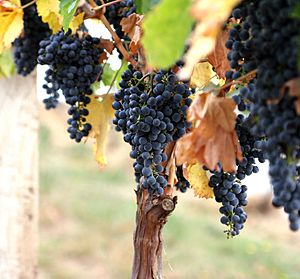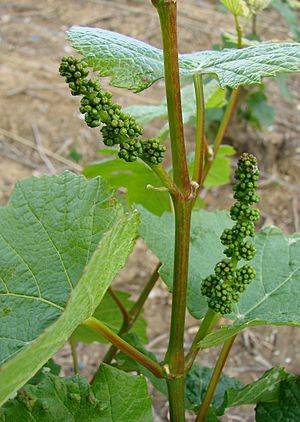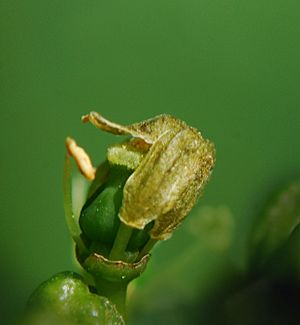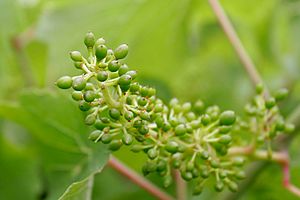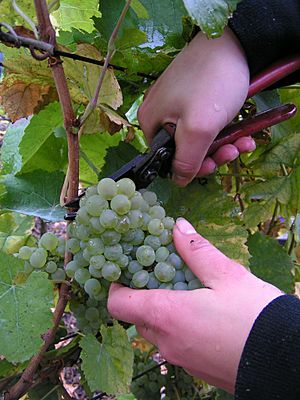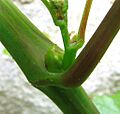Annual growth cycle of grapevines facts for kids
The annual growth cycle of grapevines is like a yearly journey for grape plants. It starts in the spring when tiny buds appear and ends in the autumn when leaves fall, followed by a winter rest period. For people who make wine, every step in this journey is super important. It helps the grapes grow just right for making delicious wine.
Vineyard experts, called viticulturists, carefully watch the vines. They check for things like the weather, plant diseases, and pests. They want to make sure the vines grow well through all the stages: bud break, flowering, fruit set, veraison (when grapes change color), harvesting, leaf fall, and finally, winter rest. If there's a problem, they might use special methods like trimming leaves, watering, or training the vines. You can usually see these growth stages in a vine's very first year. How long each stage lasts depends on the climate (warm or cool) and the type of grape variety.
Bud Break
The grape vine's yearly journey begins in the spring with something called bud break. In places like North America and Europe (the Northern Hemisphere), this usually happens around March. In places like Australia and South America (the Southern Hemisphere), it starts around September. This is when the daily temperature rises above 10 °C (50 °F).
If the vine was trimmed during winter, you might see it "bleed" a little. This means sap, which is water with some nutrients, comes out of the trimmed spots. It's like the vine is waking up!
Soon, tiny buds on the vine start to swell. These buds are small bumps found where the vine's stem meets the leaf stem. Inside each bud are usually three tiny shoots waiting to grow. They look green in the summer, turn brown in winter, and then show the first signs of green again in spring. The vine uses energy stored in its roots and wood from the year before to make these shoots grow.
As the shoots get bigger, tiny leaves appear. These leaves start making food for the vine through photosynthesis. This helps the vine grow even faster. In warm places, shoots can grow about 3 cm (1 inch) every day after about four weeks!
Sometimes, in mild winters, certain grape types like Chardonnay might start growing too early. This can be risky because young shoots are very delicate. If the temperature suddenly drops below freezing, the shoots can get damaged by frost. Vineyard managers work hard to protect them, sometimes using heaters or big fans to keep the cold air away.
Flowering
About 40 to 80 days after bud break, depending on the temperature, the vine starts to flower. Small clusters of flowers, looking like tiny buttons, appear at the ends of the young shoots. Flowering happens when the average daily temperature stays between 15–20 °C (59–68 °F). This is usually around May in the Northern Hemisphere and November in the Southern Hemisphere.
A few weeks later, the flowers grow bigger, and you can see individual tiny flowers. This is when pollination and fertilization happen. This process turns the flowers into grape berries, each containing 1 to 4 seeds.
Most grape vines grown for wine have both male and female parts in their flowers. This means they can pollinate themselves and produce fruit easily. Wild grape vines, however, might only have male or female flowers.
When a grape flower is ready, a small cap on top, called the calyptra, falls off. This releases pollen from the male parts. Wind and insects don't play a big role in grape pollination; the vine mostly pollinates itself. However, sometimes different grape varieties can cross-pollinate. For example, Cabernet Sauvignon is a mix of Cabernet Franc and Sauvignon blanc.
After pollination, the pollen fertilizes the female part of the flower. This causes seeds to form, and the flower begins to turn into a grape berry around the seeds. Bad weather like cold, wind, or rain can stop many flowers from being fertilized. This means fewer grapes will grow. It's also during this time that the buds for next year's crop start to form.
Fruit Set
The fruit set stage happens right after flowering. This is when the fertilized flowers start to grow into grape berries, each with a seed inside. In the Northern Hemisphere, this usually happens in May, and in the Southern Hemisphere, it's in November. This stage is super important because it decides how many grapes the vine will produce that year.
Not every flower gets fertilized, and the ones that don't will eventually fall off. On average, about 30% of flowers get fertilized, but this can be higher or lower. The weather and the vine's health are very important. Low humidity, high temperatures, or not enough water can greatly reduce how many flowers turn into grapes.
Sometimes, a problem called Coulure happens. This is when some berries don't form or fall off the bunch. It's often due to an imbalance in the vine's energy. Some grape types, like Grenache and Malbec, are more likely to have this problem.
Another issue is Millerandage. This is when some fertilized flowers don't form seeds, resulting in very small berries. The size of a grape berry depends on how many seeds it has, so seedless berries are much smaller. This can lead to a mix of different sized grapes in one cluster, which can be tricky for winemaking. It can be caused by vine diseases or a lack of certain nutrients. Grapes like Gewürztraminer and some Chardonnay types are prone to millerandage.
Veraison
After fruit set, the grape berries are green and hard. They have very little sugar and are full of sour acids. Then, they grow to about half their final size and enter the stage called veraison. This stage is the start of the grapes ripening. It usually happens about 40–50 days after fruit set. In the Northern Hemisphere, this is around late July and August. In the Southern Hemisphere, it's late January and February.
During veraison, the grapes change color. Red grapes turn red or black, and white grapes turn yellow or green. This color change happens because the green color (chlorophyll) in the grape skin is replaced by other colors. Red grapes get their color from pigments called anthocyanins, and white grapes get theirs from carotenoids.
The berries also start to soften as they begin to build up sugars. Within about six days of veraison starting, the berries grow a lot as they collect sugars like glucose and fructose, and their acid levels begin to drop.
Veraison doesn't happen to all grapes at once. Grapes and clusters that get more sunlight and warmth usually change color first. Grapes closer to the vine's trunk or in the shade change last. Vineyard managers can sometimes help veraison happen earlier by giving the vine a little less water or by managing the leaves so more sunlight reaches the grapes. This is because the vine naturally wants to send all its energy to the berries, which contain its seeds, to help them survive.
On the other hand, very strong vines with lots of leaves and water might delay veraison. This is because the vine is still busy growing new shoots. For making high-quality wine, it's usually best for veraison to happen earlier. During this time, the vine's woody parts also start to ripen, changing from green and flexible to brown and hard. The vine begins to store energy for its next growth cycle.
After Harvest
In the vineyard, the last big event is the harvest. This is when the grapes are picked from the vine and taken to the winery to start making wine. In the Northern Hemisphere, harvest is usually between September and October. In the Southern Hemisphere, it's between February and April.
The exact time of harvest depends on many things, especially when the grapes are considered perfectly ripe. As grapes ripen on the vine, their sugars and pH levels go up, while their acids (like malic acid) go down. Other important compounds called tannins also develop, which affect the taste and smell of the wine. The risk of bad weather or vine diseases can also influence when to harvest. Winemakers and vineyard managers decide when it's the right time by balancing all these factors.
After the grapes are picked, the vines keep making food through photosynthesis. They store this energy in their roots and trunks. They continue doing this until they have enough stored energy. Then, the green color in their leaves starts to break down, and the leaves turn yellow. After the first frost, the leaves fall off, and the vine enters its winter rest period. The next spring, the whole cycle begins again!
See Also
Images for kids


